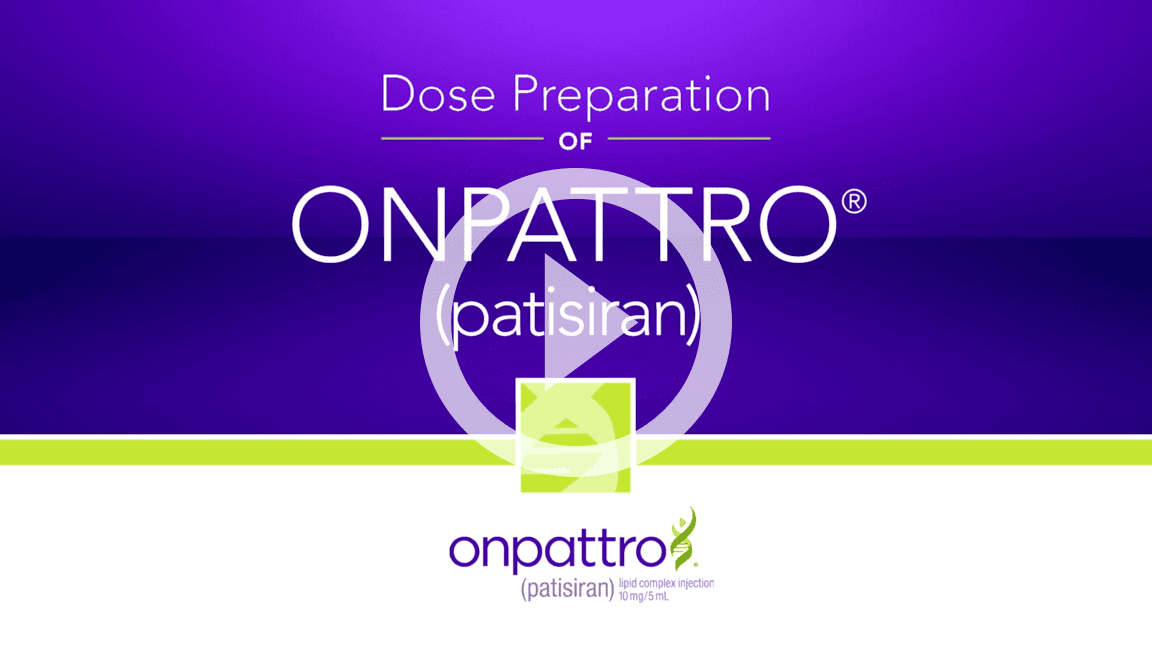ONPATTRO is given every 3 weeks1
- Patients should be given each of the following premedications on the day of the infusion, at least 60 minutes prior to the start of the infusion:
- —Intravenous (IV) corticosteroid (e.g., dexamethasone 10 mg or equivalent)
- —Oral acetaminophen (500 mg)
- —IV H1 blocker (e.g., diphenhydramine 50 mg or equivalent)
- —IV H2 blocker (e.g., ranitidine 50 mg or equivalent)
- For premedications not available or not tolerated intravenously, equivalents may be administered orally
- For patients who are tolerating their infusions but experiencing adverse reactions from the corticosteroid premedication, the corticosteroid dose may be reduced by 2.5 mg increments to a minimum dose of 5 mg of dexamethasone (IV), or equivalent
- Some patients may require additional or higher doses of 1 or more of the premedications to reduce the risk of infusion-related reactions
Laboratory monitoring is not required for ONPATTRO.
Dosing Guide*
--.-- mg
--.-- mL
-- vialsa
aCertain weights may require an additional vial of ONPATTRO due to drug product remaining in the filter. The guide above assumes that 1 mL of drug product remains in the filter when determining the number of vials needed.
*The Dosing Guide is a tool for reference. Before administration, all dose quantities should be confirmed by a qualified healthcare professional. For additional details please see the Dosing & Preparation Guide.
Step 2: Administering ONPATTRO treatment1- ONPATTRO is administered via an ~80-minute IV infusion
- Dosing is based on actual body weight
- —For patients weighing <100 kg, the recommended dose is 0.3 mg/kg
- —For patients weighing ≥100 kg, the recommended dose is 30 mg
No dose adjustment is required in patients ≥65 years old or with mild hepatic impairment or mild to moderate renal impairment.1
Dosing Guide*
--.-- mg
--.-- mL
-- vialsa
aCertain weights may require an additional vial of ONPATTRO due to drug product remaining in the filter. The guide above assumes that 1 mL of drug product remains in the filter when determining the number of vials needed.
*The Dosing Guide is a tool for reference. Before administration, all dose quantities should be confirmed by a qualified healthcare professional. For additional details please see the Dosing & Preparation Guide.
Administer ONPATTRO
ONPATTRO should be administered by a healthcare professional
Find an infusion center »
Home Administration Brochure
Important Safety Information and Indication
Important Safety Information
Infusion-Related Reactions
Infusion-related reactions (IRRs) have been observed in patients treated with ONPATTRO® (patisiran). In a controlled clinical study, 19% of ONPATTRO-treated patients experienced IRRs, compared to 9% of placebo-treated patients. The most common symptoms of IRRs with ONPATTRO were flushing, back pain, nausea, abdominal pain, dyspnea, and headache.
To reduce the risk of IRRs, patients should receive premedication with a corticosteroid, acetaminophen, and antihistamines (H1 and H2 blockers) at least 60 minutes prior to ONPATTRO infusion. Monitor patients during the infusion for signs and symptoms of IRRs. If an IRR occurs, consider slowing or interrupting the infusion and instituting medical management as clinically indicated. If the infusion is interrupted, consider resuming at a slower infusion rate only if symptoms have resolved. In the case of a serious or life-threatening IRR, the infusion should be discontinued and not resumed.
Reduced Serum Vitamin A Levels and Recommended Supplementation
ONPATTRO treatment leads to a decrease in serum vitamin A levels. Supplementation at the recommended daily allowance (RDA) of vitamin A is advised for patients taking ONPATTRO. Higher doses than the RDA should not be given to try to achieve normal serum vitamin A levels during treatment with ONPATTRO, as serum levels do not reflect the total vitamin A in the body.
Patients should be referred to an ophthalmologist if they develop ocular symptoms suggestive of vitamin A deficiency (e.g. night blindness).
Adverse Reactions
The most common adverse reactions that occurred in patients treated with ONPATTRO were upper respiratory tract infections (29%) and infusion-related reactions (19%).
Indication
ONPATTRO is indicated for the treatment of the polyneuropathy of hereditary transthyretin-mediated amyloidosis in adults.
For additional information about ONPATTRO, please see the full Prescribing Information.
Reference:
1. ONPATTRO Prescribing Information. Cambridge, MA: Alnylam Pharmaceuticals, Inc.


